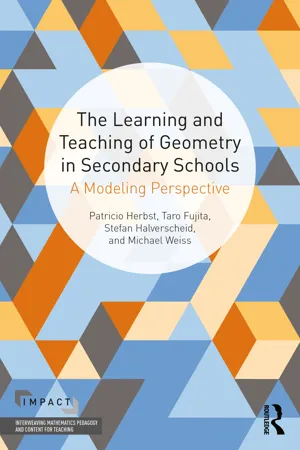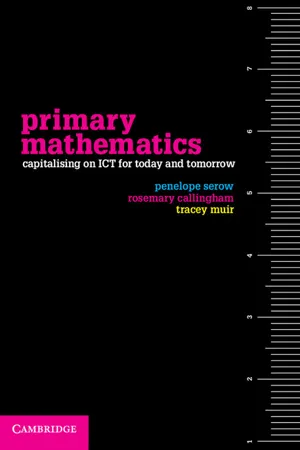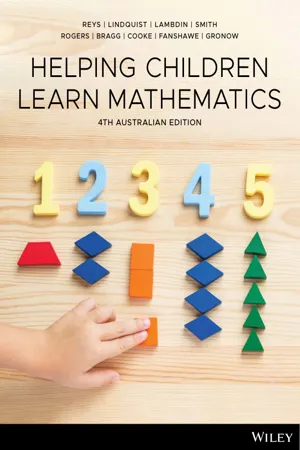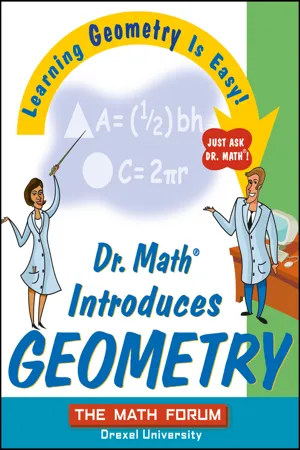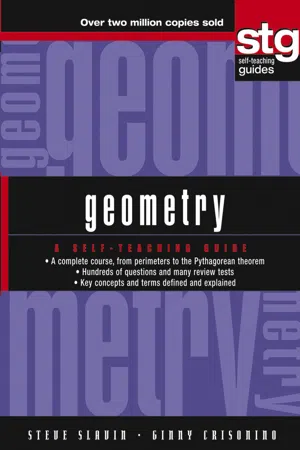Mathematics
3-Dimensional Figures
3-dimensional figures are shapes that have three dimensions: length, width, and height. Common examples include cubes, spheres, cones, and pyramids. These figures are often represented in geometry and can be visualized in physical space. They are characterized by their volume, surface area, and the number of faces, edges, and vertices they possess.
Written by Perlego with AI-assistance
Related key terms
1 of 5
7 Key excerpts on "3-Dimensional Figures"
- eBook - ePub
The Learning and Teaching of Geometry in Secondary Schools
A Modeling Perspective
- Pat Herbst, Taro Fujita, Stefan Halverscheid, Michael Weiss(Authors)
- 2017(Publication Date)
- Routledge(Publisher)
Chapter 5 .p.88 3.2.2.5. Different Conceptions of 3D FiguresIn Chapter 2 we identified the conception of figure as capture of large objects in the mesospace. While younger children’s interaction with those large objects may be mostly perceptual and proprioceptive, adolescents may be expected to model those large objects using verbal and diagrammatic representations. In such a context, their capacity to reason about geometric figures may require the engagement of sophisticated control structures. Geometric figures can be used to model such large objects, and one useful way is to draw representations of 3D objects on a piece of paper (Ben-Chaim et al., 1989). There is thinking that happens around the drawing activity, but how do students think about 3D figures with 2D representations? In Chapter 2 we referred to Parzysz (1988) who suggests that drawings or diagrams of three-dimensional figures necessarily lose information to the point of inducing a dilemma in students, between knowing and seeing the properties of 3D figures. Ben-Chaim et al. (1989) also reported that secondary school students had great difficulties in communicating properties of large 3D objects that were verbally and graphically presented in 2D formats.To understand the cognitive aspects of the dilemma between knowing and seeing , we find useful the framework “visual perception and perception-based knowledge representation (VPR)” proposed by Gal and Linchevski (2010). According to them, when we solve geometric problems we involve the processes of organization , recognition and (mental) representation (p. 166). First, in organization, shapes and objects are extracted from the visual scene (e.g., from drawing or diagrams). Then, in recognition , those objects and shapes are transformed as meaningful mental objects. Two types of processing are considered: Bottom-up (using information from the sensory physical stimulus for pattern recognition) and top-down (using general knowledge for pattern recognition; p. 170). Finally, recognized objects are represented mentally in various ways (e.g., verbally or visually). This representation - eBook - PDF
Primary Mathematics
Capitalising on ICT for Today and Tomorrow
- Penelope Serow, Rosemary Callingham, Tracey Muir(Authors)
- 2014(Publication Date)
- Cambridge University Press(Publisher)
(ACMMG009) Recognise and classify familiar two-dimensional shapes and three-dimensional • objects using obvious features. (ACMMG022) Describe the features of three-dimensional objects. (ACMMG043) • Make models of three-dimensional objects and describe key features. (ACMMG063) • Connect three-dimensional objects with their nets and other two-dimensional rep- • resentations. (ACMMG111) Construct simple prisms and pyramids. (ACMMG140) • Draw different views of prisms and solids formed from different combinations of • prisms. (ACMMG161) The spiralling nature of this process, or revisiting the same geometrical concepts over a period of time, is lost if the outcomes are interpreted literally and in an unrelated fashion. For example, it would not be appropriate to leave the drawing of 3D objects until the upper primary years. Instead, the outcomes need to be viewed holistically. It makes better sense to ask students in the first year of school to build interesting towers with a range of concrete materials and ask them to draw what they have built. It is also an opportunity lost if the students are not asked to name and describe the shapes that they have used to build their tower. This activity could also link to a mea- surement activity, where the students compare the heights of the different towers and how they are represented in their drawings. Students may begin describing the features of 3D objects as those that are pointy, those that roll, those that slide, those that have curved edges. They will begin to identify the 2D shapes on the faces of 3D objects. As with our 2D discussions, it is essential to use the correct terminology for 3D features when referring to them. In 49 Chapter 3 Exploring geometry relation to 3D objects, you may hear students describe the cube as having six sides. After affirming the student in identifying this, the discussion could move to the fact that they are called faces on a 3D object. - eBook - PDF
- Robert Reys, Mary Lindquist, Diana V. Lambdin, Nancy L. Smith, Anna Rogers, Audrey Cooke, Bronwyn Ewing, Kylie Robson(Authors)
- 2021(Publication Date)
- Wiley(Publisher)
Later, they can recognise, visualise and classify them using visible features. Over time, they can represent three-dimensional objects in drawings and models constructed from materials. Studying geometric properties of three-dimensional objects also provides an opportunity to reason and think geometrically. This section is built around the processes of: 1. describing, sorting and classifying 2. exploring, representing and constructing. Describing, sorting and classifying Children need to be able to describe properties of three-dimensional objects to compare them and explain how two or more objects are alike or different geometrically. Describing and sorting are processes that are established in early childhood and should continue throughout primary school. New and more complex properties can be added to children’s repertoire over time. Describing and sorting activities help children develop thinking at Level 1, and lead them towards Level 2 thinking, described by the van Hiele model. They are essential to developing the abstract/relational (Level 3) thinking that is a precursor to high school geometry. The activities that follow use vocabulary and include properties appropriate for beginning, intermediate, and more advanced children. Older children who have not been previously exposed to three-dimensional objects will benefit from activities such as those described in the beginning activities. Their responses, of course, will be more complex. Note: the correct terminology for describing the properties of three- dimensional solids is faces, vertices (one vertex) and edges. The teacher needs to model this language accurately. The two-dimensional language terms of sides and angles (or corners) should not be used, as it will lead to confusion. It is common for adults to model this language incorrectly. Beginning activities Children are often taught the names of geometric objects; however, they do not develop the discriminating power needed to use the names with meaning. - eBook - PDF
Dr. Math Introduces Geometry
Learning Geometry is Easy! Just ask Dr. Math!
- (Author)
- 2004(Publication Date)
- Jossey-Bass(Publisher)
W e’ve looked a lot so far at one- and two-dimensional objects. In this part we’ll look at three-dimensional objects, or solids. Do you remember how it was useful to know something about lines in order to work with polygons and circles? Well, it’s useful to know things about polygons and circles in order to work with three-dimensional objects. They’re all made using two-dimensional figures, after all: the square can tell you something about the cube, or the square prism; the circle helps you figure out the sphere, the cylinder, and even the cone; the triangle is useful for the tetrahedron and other 105 Introduction to Three-Dimensional (3-D) Geometric Figures Introduction to Three-Dimensional (3-D) Geometric Figures Introduction to Three-Dimensional (3-D) Geometric Figures PART 4 5 106 Dr. Math Introduces Geometry 1 1 Platonic solids and pyramids. Don’t know what Platonic solids are? We’ll introduce you to them in this section! In this part, Dr. Math explains • polyhedra • Platonic solids • surface area • volume • nets of solids Polyhedra “Polyhedra” is the plural of “polyhedron.” The root “poly” is from the Greek word for “many” (which you might remember from “polyno- mial”). “Hedron” means “face.” Compare this with the word “poly- gon”: “gon” is from the Greek word “gonu,” which means “angle.” So a polygon is a figure with many angles, and a polyhedron is a fig- ure with many faces. Knowing where the words come from can help you remember what they mean. In this section, we’ll look at the many-faced polyhedra. Dear Leon, The objects you’ve asked about are solids, not plane figures. The ending “-hedron” tells you that these are three-dimensional shapes that have faces rather than sides like a triangle or a square. They have not only length and width but also depth. Dear Dr. Math, I know what a polygon is, but now I’ve heard the word “polyhedron.” What is it? Yours truly, Leon What Is a Polyhedron? - eBook - PDF
Mathematics for Elementary Teachers
A Contemporary Approach
- Gary L. Musser, Blake E. Peterson, William F. Burger(Authors)
- 2013(Publication Date)
- Wiley(Publisher)
Describe attributes and parts of two- and three-dimensional shapes. Recognize and create shapes that have symmetry. Recognize and represent shapes from different perspectives. GRADES 3-5–GEOMETRY Identify, compare, and analyze attributes of two- and three-dimensional shapes and develop vocabulary to describe the attributes. Classify two- and three-dimensional shapes according to their properties and develop definitions of classes of shapes such as triangles and pyramids. GRADES 6-8–GEOMETRY Precisely describe, classify, and understand relationships among types of two- and three-dimensional objects using their defining properties. Use two-dimensional representations of three-dimensional objects to visualize problems. Key Concepts from the NCTM Curriculum Focal Points PRE-K-2: Identifying shapes and describing spatial relationships. KINDERGARTEN: Describing shapes and space. GRADE 1: Composing and decomposing geometric shapes. GRADE 3: Describing and analyzing properties of two-dimensional shapes. GRADE 5: Describing three-dimensional shapes and analyzing their properties, including volume and surface area. GRADE 8: Analyzing two- and three-dimensional space and figures by using distance and angle. Key Concepts from the Common Core State Standards for Mathematics KINDERGARTEN: Identify and describe two- and three-dimensional shapes (squares, circles, triangles, rect- angles, hexagons, cubes, cones, cylinders, and spheres). Analyze, compare, create and compose two- and three-dimensional shapes GRADE 1: Reason with two- and three-dimensional shapes and their attributes (defining and non-defining) GRADE 2: Reason with two- and three-dimensional shapes and use their attributes (defining) to draw shapes. GRADE 3: Reason with two-dimensional shapes across different categories (e.g., rhombuses, rectangles, and quad- rilaterals) and their attributes. GRADE 4: Draw and identify lines and angles, and classify shapes by properties of their lines and angles. - eBook - PDF
Geometry
A Self-Teaching Guide
- Steve Slavin, Ginny Crisonino(Authors)
- 2004(Publication Date)
- Wiley(Publisher)
Until now we’ve been doing plane geometry, which involves only two dimensions: generally width and length, or base and height. To these we now add depth, as we move from plane geometry to solid geometry. You’re probably much too young to remember three-dimensional (3D) movies, which introduced the third dimension to cinematography. Back in the mid-1950s, moviegoers would be given special disposable dark glasses to wear. The effect was a lot like watching an IMAX movie today (only without the glasses). The most famous 3D movie of the time was Cinerama, which provided viewers with the thrilling experience of riding at the front of a roller coaster. Def- initely not a movie for the squeamish. Now back to the less thrilling world of solid geometry. When you have com- pleted this chapter, you will know how to compute the volume and surface area of • cubes • rectangular solids • pyramids • spheres • cylinders • cones • complex figures Before we get started, we’d like you to try the following pretest. If you answer all the problems correctly, you can skip to the next chapter. PRETEST 1. How much larger is the surface area of a cube with an edge of 6 meters than a cube with an edge of 4 meters? 2. Find the volume of a rectangular solid with a length of 8 inches, a width of 6 inches, and a height of 4 inches. 3. What is the surface area of a three-sided pyramid that has a height of 7 feet and a base with an area of 12 feet? 4. If natural gas costs $2 per cubic foot, how much would it cost to fill a spheri- cal tank with a radius of 40 feet? 5. Ike’s Ice Cream Parlor serves one-scoop ice cream cones with a perfect hemi- spherical scoop of ice cream on the cone. If the radius of the cone and hemi- sphere is 2 inches and the cone has a height of 6 inches, how many cubic inches of ice cream are in Ike’s ice cream cones? 6. - eBook - PDF
- Tom Bassarear, Meg Moss(Authors)
- 2019(Publication Date)
- Cengage Learning EMEA(Publisher)
496 CHAPTER 8 Geometry as Shape Four of the pictures are of objects made by humans, and two are natural—one organic and one inorganic. The snail (in its genetic makeup) and the crystal (in its molecular makeup) have the “blueprints” for the ultimate shape of the shell and of the crystal. Both the pyramid and the Parthenon are over 2000 years old, and yet the geometry that was used to make them is relevant to building today. The massive pyramid at Giza is one of the seven wonders of the ancient world. Even today we are not certain how it was constructed. Many of the blocks weighed more than 10 tons! The pyramid was originally covered with white marble and must have dazzled like a mirror in the desert. It was so well-built that some of the edges fit together so well that a razor blade cannot be inserted into the space between two blocks. The soccer ball and the design on the roof of the mosque represent the solution to two different questions about connections between two dimensions and three dimensions. In the former case, someone discovered that a specific combination of two polygons (a regular pentagon and a regular hexagon) will produce a nearly perfect ball (sphere). In the latter case, the designers had to figure out how to take a two-dimensional tessellation design and “fold” it around the roof of the shrine so that it would “work” in three dimensions. Just as we discovered patterns and relationships among many two-dimensional objects, there are many patterns and relationships among three-dimensional figures, also called space figures. Under- standing the geometry of human-made objects helps us to make them work better and, in the case of objects such as bridges, overpasses, and airplanes, to make them work more safely. Geometry also helps us to understand natural phenomena better—for example, why certain animals have the shapes they have. An understanding of shapes has many applications in science.
Index pages curate the most relevant extracts from our library of academic textbooks. They’ve been created using an in-house natural language model (NLM), each adding context and meaning to key research topics.
